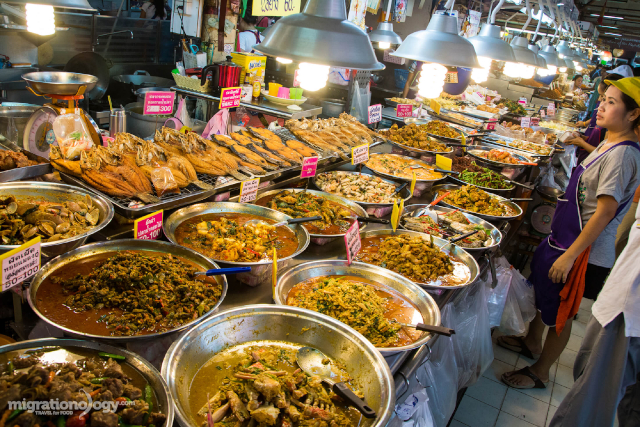Folks often ask how Street Food and Fine Food became so distantly separated on the dining continuum. The odd thing, to me, is why are the fine-dining and street food concepts differentiated in just the same ways, regardless of culture or traditions…
 Bangkok Street Food stand: Street Food will prevail
Bangkok Street Food stand: Street Food will prevail
when bogus cultural constructs have failed…
The secret is simple
At least to me. Street Food is a list of a culture’s classic and traditional dishes, available everywhere. Fine Food is a description of a high-end dining experience, often defined as much by ambience, fancy presentation and exotic ingredients as it is by tradition or the shared experience of a cultural group. Fine Dining is, in fact, pretty much the same regardless of where you partake of it.
When I asked myself why the foregoing is so often true, two things popped up in my awareness. ‘Fine Dining’ is just that; an experience. ‘Street Food’ is all about the food, regardless of the decor, music or pomp. A fancy frame for a simple picture.
The food is often the same
Oddly, the closer I look at the most famous street Food cultures, the more apparent it becomes. I am struck by how many times reviewers, travel writers and just plain snobs equate the two as polar opposites. They remark about how such-and-such a hotel in such-and-such an Asian (or Middle Eastern, or European) metropolis offers the best of it’s own culture’s traditional cuisine right alongside of the most beloved dishes from ‘international’ cuisine.
I have a few observations…
… As always.
First, I want to remark on my last point above. If you want a really great steak. Why go all the way to the Penninsula Hotel in Hong Kong? You can cut thousands off the airfare and accommodation costs by simply bussing or driving out to Omaha or Kansas City, the capitals of the cattle drive culture of the Old West, and drinking in their appropriate and historic ambience?
Other famous foods are , similarly, meant to be enjoyed in the environments in which they originated. Drink espresso and eat croissantes in a Paris café. Laze away an afternoon drinking iced Fino Sherry and nibbling Tapas in a Portuguese or Spanish bar. Grab English Fish and Chips at a classic London Chip Shop or street cart.
Yes, you can get the aforementioned Fish and Chips at London’s most ancient and venerable Fine Dining establishments, or its priciest new-cuisine restos. But you’ll miss the street action, the lilt of the local accents, the background sounds and aromas, and all the other aspects of the street ambience that make the Street Dining experience just as rich or richer than the universal ‘white table cloth’ show.
Second, the reason the ‘white table cloth’ experience is so similar wherever in the world you encounter it is, I suspect, that it has evolved from a single ancestor: the style and ‘rules’ set down by Catherine de Medici, when she married Henry II of France and imported all the main ingredients of ‘modern’ food, prep and service from her family home in Italy. The use of the forks and spoons at the table, napkins and table cloths, china plates, standardized techniques and ingredients. Those and many more ‘rules’, were first introduced in France, quickly spread to Europe. Then, from there, migrated around the world with European explorers and conquerors.
Third, the most famous indigenous dishes of almost every culture are present on both the low and high-end menus. They’re just cheaper and (arguably) more authentic on the street than they are in the fancy high-end eateries. My theory is, the white table cloth guys have somehow got the idea that they have to tart up their homeland’s best and present it in the European way: on a single plate, with protein, starch and the equivalent of 2 veg. What a shame. And what an insult to the fabulous, flavourful and, by tradition, simple dishes that define the world’s most ancient and exotic cuisines.
Bottom line
Street Food is a cornerstone concept in the structures of different cultures wherever you go. ‘Fine Dining’ is an artificial construct; a relic of the 18th and 19th Century belief that ‘Europe was meant to rule the world and raise up the backward savages elsewhere’. And remake other cultures in the image of Western Civilization’.
The Fine Dining concept reached no higher a degree of perfection than than on the upper decks of the great European passenger liners of the 19th and early 20th centuries – the Titanic for example. The European ‘style setters’ could literally take their overblown standards with them anywhere in the world they went!
That notion of Fine Dining being somehow superior is just as outdated as the other constructs that Europeans foisted on the world in eras gone by. Like slavery, Noblesse Oblige, the oppression of women and class distinctions.
But the real bottom line is: Street Food will still be in the streets long after the artificial constructs that define so much of modern cultures have crumbled and been replaced by the next fad or trend…
~ Maggie J.

